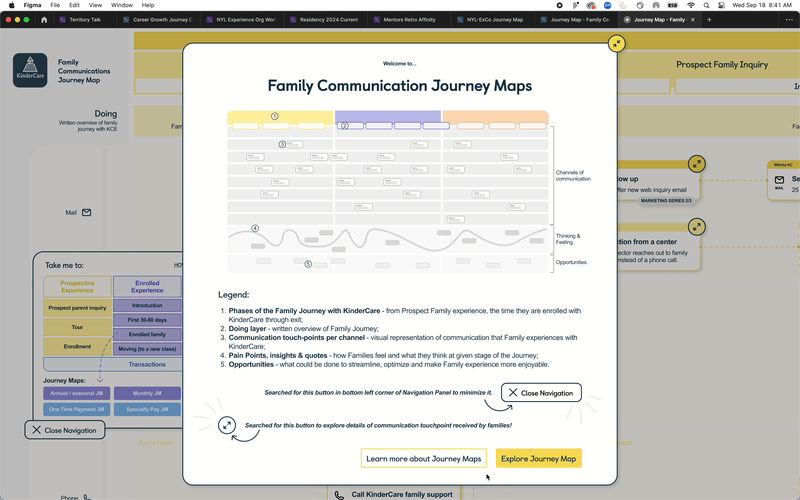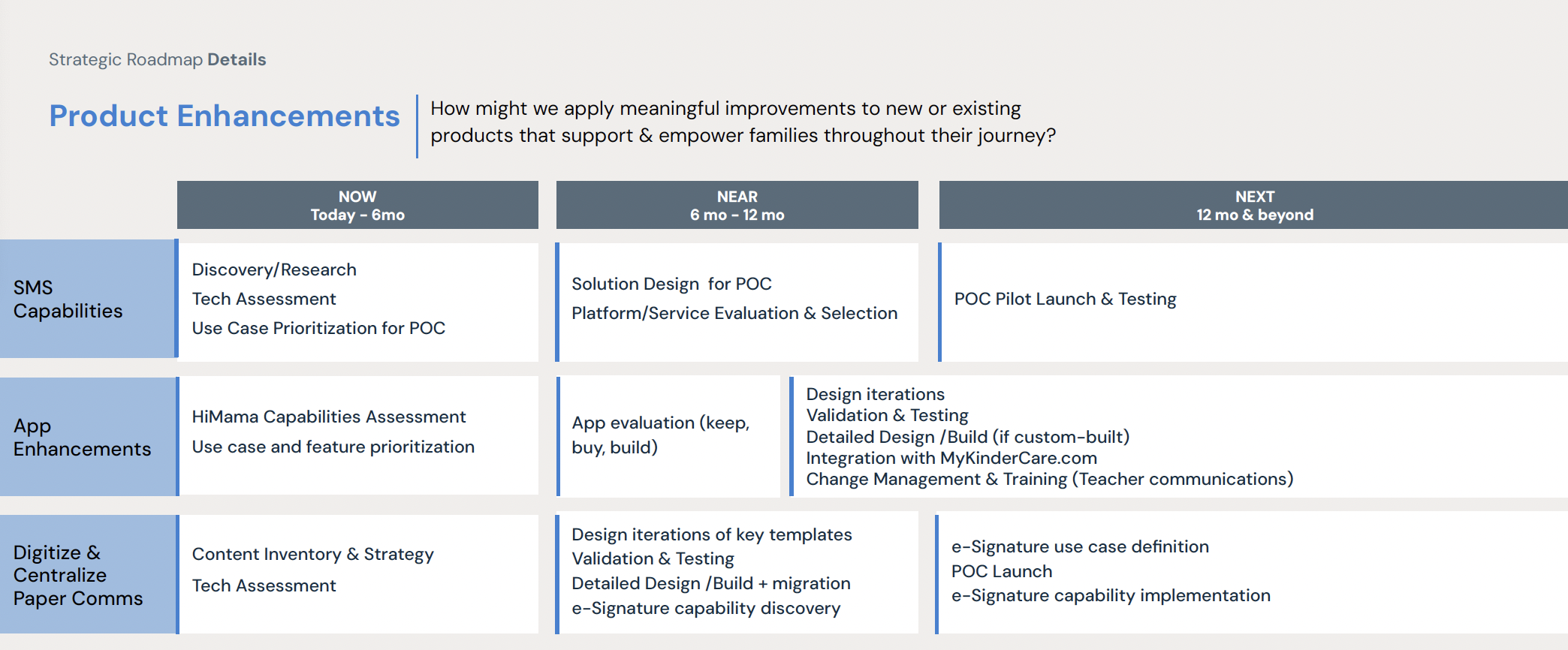A communications strategy that is family obsessed.
Our team partnered with KinderCare to research the current state of family communications and to craft a clear, actionable, family-centric communications strategy for KinderCare and its centers. We set out to interview stakeholders, center directors and family to gain a holistic understanding of the communications and business landscape.
Due of the shear scale of the organization, with over 700 centers nationwide, KinderCare had never fully mapped the complexities that are family communications. They were eager to understand the current landscape and use research to improve upon strategies in the future.
My Role
Experience strategy lead
Methodologies
Discovery research, qualitative research, journey mapping, opportunity prioritization
The Global team
3 experience strategists
1 product designer
Deliverables
Insights report, communications strategy, roadmap, journey maps
Project Plan
Immersion & discovery | Months 1 –2
Researching family needs.
As the experience strategy lead, I guided the team throughout the initial weeks of the engagement, which was primality diving into the current state and conducting qualitative research. I placed a strong importance on intentional research to guide our current state journey mapping and subsequent strategic recommendations.
The team prepared for interviews with sixteen stakeholders across various business areas, including marketing, operations, IT and more, providing our team a foundational understanding of family communications today. We then conducted center visits and interviews with center directors (individuals leading a single KinderCare center’s daily operations) in locations across the US to contextualize our insights from stakeholders. Subsequently, we held 1:1 qualitative interviews with twelve families to gain first-hand insight into their experience engaging with KinderCare. Our team intentionally met with families who presented a variety of key criteria, including:
Those who are new to KinderCare, and those who had been with the company for over a year
Mix of private pay (paying tuition out of pocket) and speciality pay (those on payment programs)
Mix of urban, rural and suburban locations across the US
Synthesis
Findings & Insights






Frameworks
After the team completed all interviews, we used out findings and insights to craft a family & child-centric framework that guided us throughout the remainder of the engagement.
Define & Design | Months 3 – 4
Visualizing the current state.
Using our research and subsequent insights from synthesis, we turned to illustrate the current state family journey. As we suspected, each family’s experience is unique. Each family unit is unique, and each KinderCare center has their unique way of handling the day to day with their families. With that in mind, we stayed true to our research and mapped the complexities of each family journey as related to overarching steps in an average lifecycle with KinderCare.
Prospecting
Prospect Parent Inquiry
Families lead many conversations with KinderCare in this phase, however they don’t always know what the right questions to ask are
Tour
Families are often not well-equipped for tours and are unsure of what to expect and are often unsure of next steps
Enrollment
Families experience a lengthy enrollment process and interact with a number of documents in both digital and paper form
Enrolled Family
Introduction Through First Day
Families value all efforts from their center to get to know their children and are happy to provide additional information to make their first weeks as successful as possible
First 30-60 Days
Only some families experience a formal onboarding session, which is generally organized by the center director
Enrollment
Families almost always prioritize communication coming directly from their center, especially information related to their child
Moving (to a new class)
Some centers communicate with families more than others surrounding the transition period
Exit
Moving (to a new center)
Families must complete additional paperwork for the new center, which are sometimes duplicative of initial enrollment forms
Leave or Exit KinderCare
Families inform their center director of their decision to leave via email or in person, depending on the needs of the family
Mapping family communications.
Due to the complexities of each family journey, our team broke down the end to end journey into phases (from above). The team mapped what a family was doing in a given phase, the communication channels used, a family’s emotional journey (supported by research), and opportunities. Because of the shear amount of information, our product designer created an interactive map that was easy to read and navigate. This effort was eventually translated for use in Figma as the first of its kind Journey Map Kit.
Day in the life journeys
To level up our storytelling & to support our family-first framework, we mapped hypothetical (grounded in research) communications for three families, each exploring different levels and types of communications based on their unique reality. Although most days are routine for families, we crafted these views to understand the variations that can occur in communications for families of different circumstances and geographic location.





Deliver | Months 4 –5
Crafting a research-informed communications strategy.
With research and current assessments wrapped, we shifted our attention to the future of communications for KinderCare & families. We identified that families look for three things from their communications with KinderCare:
Care
Families want to feel cared for, guided, and supported throughout their journey with KinderCare.
Control
Families want to be communicated with in ways that feel right to them and empowered to find answers they need when they need them.
Consistency
Families want cohesive, consistent communications that helps them build and maintain trust in KinderCare.
With this in mind, we encouraged KinderCare to start thinking from a ‘family-first’ perspective, meaning putting ourselves in our customer’s shoes and orienting communications around what families want most. To enable this shift, we suggested six areas of strategic focus for the future of communications.
Opportunities
Strategic roadmapping.
With opportunities identified, we got tactical and mapped out how KinderCare might approach these opportunities in order to: show families we care, empower families to find what they need & when, and creating consistent and connected experiences in an effort to to establish KinderCare family communications to further advance the digital family experience vision and be more family-first. To do so, e used a boilerplate “now, near, next” framework catered to KinderCare’s needs
Now
Quick wins and immediate best actions KinderCare can begin working on today (1 – 6 months)
Near
Discovery & strategic foundations to begin working against longer term opportunities (6 – 12 months)
Next
Opportunities that are either aspirational, dependent on others or need additional definition to be fully planned (12+ months)
Sample of roadmap
Next Steps
Where does KinderCare go from here?
The team presented a series of roadmaps aligned to the identified opportunity areas, providing guidance to KinderCare on how best to approach each in a chronological format.
Overall, the team suggested that KinderCare follow steps below to achieve each –
Align on priorities and actionable roadmap, with input from the business & field
Expand operational considerations and capabilities to determine staffing and departmental involvement
Craft vision statement for the Family Communications Value Stream







